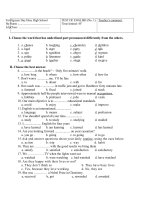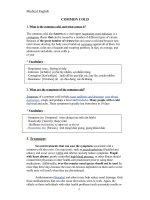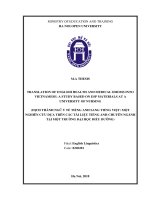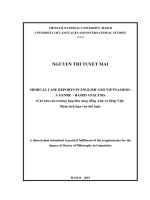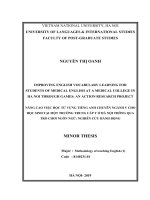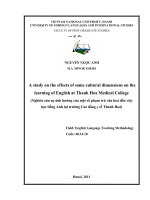medical english
Bạn đang xem bản rút gọn của tài liệu. Xem và tải ngay bản đầy đủ của tài liệu tại đây (253.36 KB, 11 trang )
Medical English
COMMON COLD
1. What is the common cold, and what causes it?
The common cold, also known as a viral upper respiratory tract infection, is a
contagious illness that can be caused by a number of different types of viruses.
Because of the great number of viruses that can cause a cold and because new
cold viruses develop, the body never builds up resistance against all of them. For
this reason, colds are a frequent and recurring problem. In fact, on average, and
adolescents and adults, seven colds p
er year
* Vocabulary :
- Respiratory tract : Đường hô hấp
- Infection [in'fek∫n] (n) Sự lây nhiễm, sự nhiễm trùng
- Contagious [kən'teidʒəs] (adj) dễ lây qua tiếp xúc; hay lây; truyền nhiễm
- Resistance [ri'zistəns] (n) sự chịu đựng; sức đề kháng
2. What are the symptoms of the common cold?
Symptoms of a common cold include nasal stuffiness and drainage, sore throat,
hoarseness, cough, and perhaps a fever and headache. Many people with a cold
feel tired and achy. These symptoms typically last from three to 10 days
* Vocabulary :
- Symptom (n) ['simptəm] triệu chứng (của một căn bệnh)
- Nasal (adj) ['neizəl] ( thuộc) mũi
- Stuffiness (n) ['stʌfinis] sự nghẹt mũi, sự tắc mũi
- Hoarseness (n) ['hɔ:snis] tình trạng khản giọng, giọng khàn khàn
3. Treatment:
Several treatments that can ease the symptoms associated with a
common cold also exist. Decongestants, such as pseudoephedrine (Sudafed and
others), and nasal sprays (Afrin and others) can help reduce symptoms. People
with heart disease, poorly controlled high blood pressure, or other illness should
contact their physician or other health-care practitioner prior to using these
medications. Additionally, over-the-counter nasal sprays should not be used for
more than three days because the nose can become dependent on them and a worse
stuffy nose will result when they are discontinued.
Antihistamines (Benadryl and others) may help reduce nasal drainage. Only
those antihistamines that can also cause drowsiness seem to work. Again, the
elderly or those individuals with other health problems (such as prostate trouble or
1
Medical English
constipation) should contact their health-care practitioner before using these
medications.
Acetaminophen (Tylenol and others) or ibuprofen (Advil and others) can
help with the muscle aches. Cough can be controlled with cough syrups containing
dextromethorphan. Finally, drink lots of fluids, use throat lozenges for sore throat,
and stay in a moist environment (for example, running a humidifier at night may
help with the symptoms).
- Decongestant (n) Thuốc làm thông mũi
* Grammar and practice:
1. The great number of + N ( plural)
2. The relative clause:
3. The passive voice:
- Active voice: S + V + O
- Passive voice: O => S + BE + V-ed/ V + (by O <= S)
2
Medical English
INFLUENZA
1. What is influenza?
Influenza, commonly called "the flu," is an illness caused by viruses that
infect the respiratory tract. Compared with most other viral respiratory infections,
such as the common cold , influenza (flu) infection often causes a more severe
illness with a mortality rate (death rate) of about 0.1% of people who are infected
with the virus.
Haemophilus influenzae is a bacterium that was incorrectly considered to
cause the flu until the virus was demonstrated to be the correct cause in 1933. This
bacterium can cause lung infections in infants and children, and it occasionally
causes ear, eye, sinus, joint, and a few other infections, but not the flu.
2.What are flu symptoms?
* Typical clinical features of influenza include
• - fever (usually 100° F to 103° F in adults and often even higher
in children)
- respiratory symptoms such as
- cough, sore throat, runny or stuffy nose, headache, muscle aches, and
fatigue, sometimes extreme.
3
Medical English
Although nausea, vomiting, and diarrhea can sometimes accompany
influenza infection, especially in children, gastrointestinal symptoms are rarely
prominent. The term "stomach flu" is a misnomer that is sometimes used to
describe gastrointestinal illnesses caused by other microorganisms.
Most people who get the flu recover completely in one to two weeks, but
some people develop serious and potentially life-threatening medical
complications, such as pneumonia. In an average year, influenza is associated with
about 20,000 deaths nationwide and many more hospitalizations. Flu-related
complications can occur at any age; however, the elderly and people with chronic
health problems are much more likely to develop serious complications after
influenza infection than are younger, healthier people.
- Pneumonia (n) Viêm phổi
4
Medical English
CHICKENPOX
1. What is chickenpox? What causes chickenpox?
Chickenpox is a common childhood skin disease caused by a virus. The
virus is called the varicella -zoster virus.
Most people contract chickenpox by age 15, the majority between ages 5
and 9, but all ages can contract it. Chickenpox is usually more severe in adults and
very young infants than children. Winter and spring are the most common times of
the year for chickenpox to occur.
2. What are the signs and symptoms of chickenpox?
Symptoms tend to appear 14 to 16 days after the initial exposure but can occur any
time from 10 days up to 21 days after contact with the virus. Chickenpox is
characterized by one to two days of mild fever, general weakness, and a rash, often
the first sign of the disease. Rarely, a person may have the disease without the rash.
The rash of chickenpox develops in crops with raised red spots arriving first,
progressing to blisters that burst, creating open sores, before crusting over. This
process usually starts on the scalp, then the trunk (its area of greatest
concentration), and finally the arms and legs. Any area of skin that is irritated (by
diaper rash, poison ivy, eczema, sunburn, etc.) is likely to be hard hit by the rash.
The rash is typically very itchy (pruritic
GENERIC NAME: acetaminophen
BRAND NAME: Tylenol and others
DRUG CLASS AND MECHANISM: Acetaminophen belongs to a class of drugs
called analgesics (pain relievers) and antipyretics (fever reducers). The exact
mechanism of action of acetaminophen is not known. Acetaminophen relieves pain
by elevating the pain threshold, that is, by requiring a greater amount of pain to
develop before a person feels it. It reduces fever through its action on the heat-
regulating center of the brain. Specifically, it tells the center to lower the body's
temperature when the temperature is elevated. The FDA approved acetaminophen
in 1951.
PRESCRIPTION: No.
5


